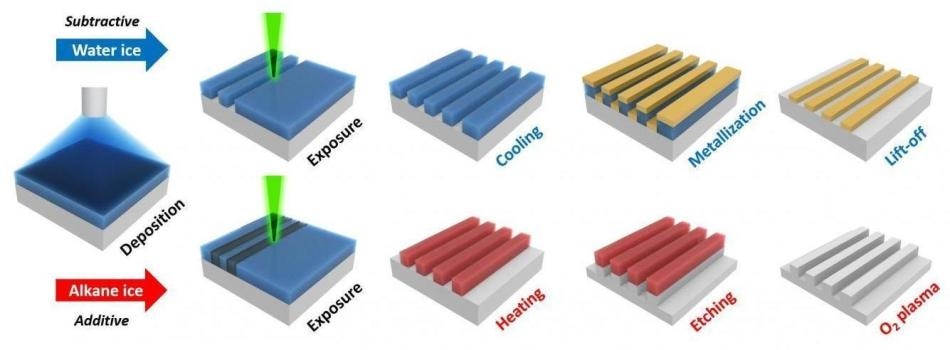Nanofabrication facilitates nanoscience and nanotechnology. One of the founding stones of nanofabrication is electron-beam lithography (EBL), which involves making patterns down to a few nanometers.
 IL process flow. Water ice acts as a positive-tone lithography resist, and alkane ice demonstrates a negative-resist-like capability. (Image credit: Science China Press)
IL process flow. Water ice acts as a positive-tone lithography resist, and alkane ice demonstrates a negative-resist-like capability. (Image credit: Science China Press)
In the past 10 years, considerable progress has been made in electron-beam-based nanofabrication, for example, the emerging ice lithography (IL) technology, where ice thin-films are employed as resists and patterned by a focused electron-beam. The whole process of IL nanofabrication is streamlined and sustainable since chemical developing and spin coating steps usually needed for EBL resists are rendered unessential.
A fresh examination titled “Ice lithography for 3D nanofabrication” by Prof. Min Qiu at Westlake University has been reported in Science Bulletin. In this report, the researchers have illustrated the current status and future prospects of ice lithography (IL). Different ice resists and IL instrument design have also been presented. Special attention has been given to the benefits of IL for 3D nanofabrication.
In 2005, the Nanopore group at Harvard University first proposed the IL technology. The first recognized ice resist for IL is water ice, and it is still the only one positive-tone lithography resist thus far. Water ice can be easily eliminated from within the electron-beam exposure area.
Organic ice condensed from simple organic molecules like alkanes exhibits a negative-resist-like potential, meaning that only exposed patterns stay on the substrate once the sample is heated to room temperature.
Although IL research is only in its formative years, this technique has already shown excellent benefits in effective 3D nanofabrication. In contrast to spin coating of EBL resists, ice resists can coat all accessible freezing surfaces of the sample at the time of ice deposition. Hence, IL can be used to process samples that have irregular and non-flat surfaces, like patterning on AFM probes and pattern on a tiny and fragile nanostructure, like suspended single-walled carbon nanotubes.
IL benefits from the extremely low sensitivity of water ice and thus enables in situ observation of nanostructures under the ice resist by means of SEM imaging. Apart from enhancing the alignment accuracy, this feature also simplifies the processing steps in developing 3D layered nanostructures.
Since state-of-the-art instrument research and development is vital for developing the IL technology, the study finally examines the evolution of IL instruments and offers an evident guidance on the development of a dedicated IL instrument. The finding of innovative functional ice resists in future could open the door for more sophisticated and interdisciplinary studies to take advantage of the potentials of IL.
This study was supported by the National Natural Science Foundation of China (Grant No. 61425023), National Key Research and Development Program of China (Grant No. 2017YFA0205700), and European Union’s Horizon 2020 research and innovation program under the Marie Skodowska-Curie grant agreement (Grant No. 713683).
Source: http://www.scichina.com/

